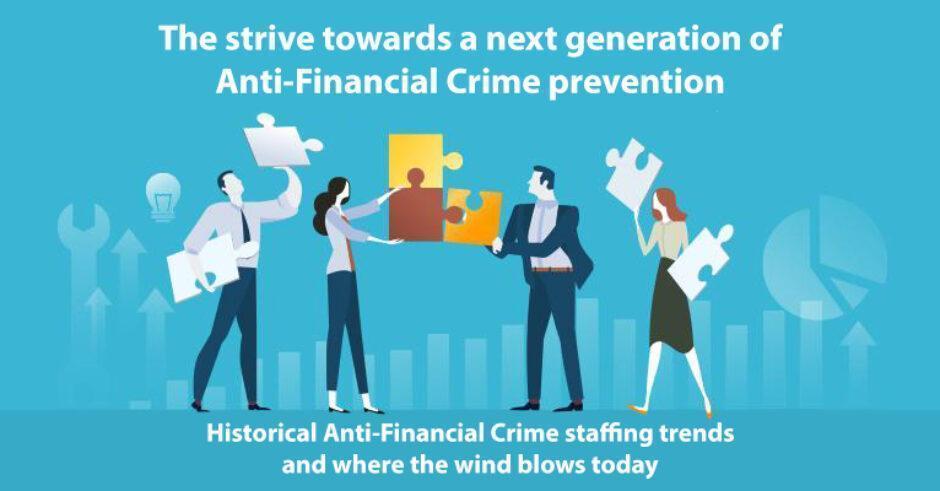Historical Anti-Financial Crime staffing trends and where the wind blows today
The ongoing discourse in the Anti-Financial Crime (AFC) area is typically characterised and centred around topics such as e.g. how to conduct proper due diligence, how to identify a beneficial owner, what an effective AML/CTF compliance program looks like etc. Not very often discussed nor the most evident or central topic in the AFC space is the topic of Recruitment and Staffing. Nevertheless, it is an always existing challenge and in our opinion a game-changer in today’s AFC work and therefore worthwhile examining a bit closer. Due to new prerequisites of the AFC area, Recruitment and Staffing assume central positions in the next generation of AFC prevention.
The recruitment winds within the field of AFC prevention have certainly escalated into a full-blown tornado during the last couple of years. And speaking of where the wind blows, the AFC recruitment wind has, during the last ten years, not been blowing in a consistent direction. The only consistent thing about it is that it has not been consistent at all. What is certain though is that the demand for AFC professionals is higher than ever before. The question is, however, if banks have a future-looking recruitment strategy – i.e. is it the right type of professionals that is in demand?
The shift from rule-based to risk-based
Ten years ago, the situation looked quite different from today. This was a time when the Compliance function in banks was not often separated from the first line Anti-Money Laundering/Countering Terrorism Finance Officers (AML/CTF Officers); a time when those working with AML/CTF related questions were almost solely Legal Counsels and Lawyers and the implemented transaction monitoring scenarios in the system were the ones “you got with the installation”.
The third Anti-Money Laundering Directive from 2009 has become a highlight within the AFC world, as it set the foundation for today’s risk-based AML/CTF prevention work. This was also the moment when some banks started realising that more competencies were needed than just legal expertise – i.e. that an effective AML/CTF approach consisted of more than simply frameworks, governance and legal interpretations. The development since then has not been as rapid or straightforward as one would have expected. There have been challenges in bringing together the traditional legal expertise and the Risk Analysts. If your legal AML/CTF experts and your Risk Analysts have started to chit chat at the coffee machine – you are up to a good start. If you’ve already got these two roles working together in perfect harmony – you are probably past the 2000s way of thinking and have realised that these two roles need to work closely together for the efficient and practical implementation of the legal requirements.
The risk-based approach was the first major change of direction in our time and led to the introduction of Risk Analysts within the field of AFC. If Compliance Officers were the new rock stars of banking, the Risk Analysts would soon be the new rock stars in the AFC world.
The risk-based approach, which is more present than ever, compels banks to take measures to identify, evaluate and understand the threats they are exposed to. While such efforts will not entirely make it possible to keep up with the pace of criminals, it still implies that Risk Analysts are here to stay.
Massive KYC overhaul
Jumping ahead a couple of years to the mid-2010s. FSA’s around the world were increasingly daring, handing out fines of all sizes to banks across the globe. Forcing banks to recon their AML/CTF legacy. What had not been done by then, needed to be corrected as a matter of urgency. This introduces us to the next major change in AML/CTF recruitment – the massive recruitment of KYC Officers. Banks that lacked documented KYC on their customers needed to collect it – and at hurricane-fast speed! Manual labour within AFC prevention primed during the late 2010s and nobody had a minute left over to think “what if robotics could solve this KYC gathering for me?”.
New rock stars on the stage – data scientists and quants
Jumping ahead once more to today; the early 2020s. Winds have shifted yet again, and we feel the tech-storm coming – actually, it is already here! New tech means two things: less need for manual labour and more need for Data Analysts, Data Scientists and Quants! If anyone was patiently waiting backstage at the rock star concert – it was the Quants of AFC prevention.
As banks try to move on from the trauma of billion-dollar fines, the demand for effectiveness in AFC prevention rises more and more. This is typically a lengthy transition process delayed by technical transition inertia. New tech such as Artificial Intelligence, Machine Learning, Robotics and the quantification and visualisation of AML/CTF-related processes, require big investments and daring decisions in order to replace old IT legacy and to build effective and quant-driven AFC regimes. This inevitably takes time and, similarly, requires adjustments to recruiting and staffing strategies to fully reap the benefits and achieve the full potential of creating a next-generation AFC regime.
Looking into the crystal ball, however, our best guess is that Risk Analysts and Quants together with high-level commitment is the basic prerequisite of today in order to build a relevant and truly risk-based AFC regime for the 2020s and beyond.
Processes need automation and monitoring systems to need to be smarter. If the tech side developments can be effectively and successfully coupled with a recruitment strategy, it will allow the more traditional legal AML/CTF professionals to be teamed up with the AML/CTF Risk Analysts and Quants. This, in turn, will enable banks to move into the next generation of AFC prevention where new tech and the right staffing is key.
Next-generation AFC prevention is conditioned upon a successful merge of traditional AML/CTF officers, Risk Analysts and Quants. However, to enjoy the full potential and reap the benefits of the merge of competencies, the staffing also needs to strike the right balance between different types of personalities – something we refer to as “archetypes”.



